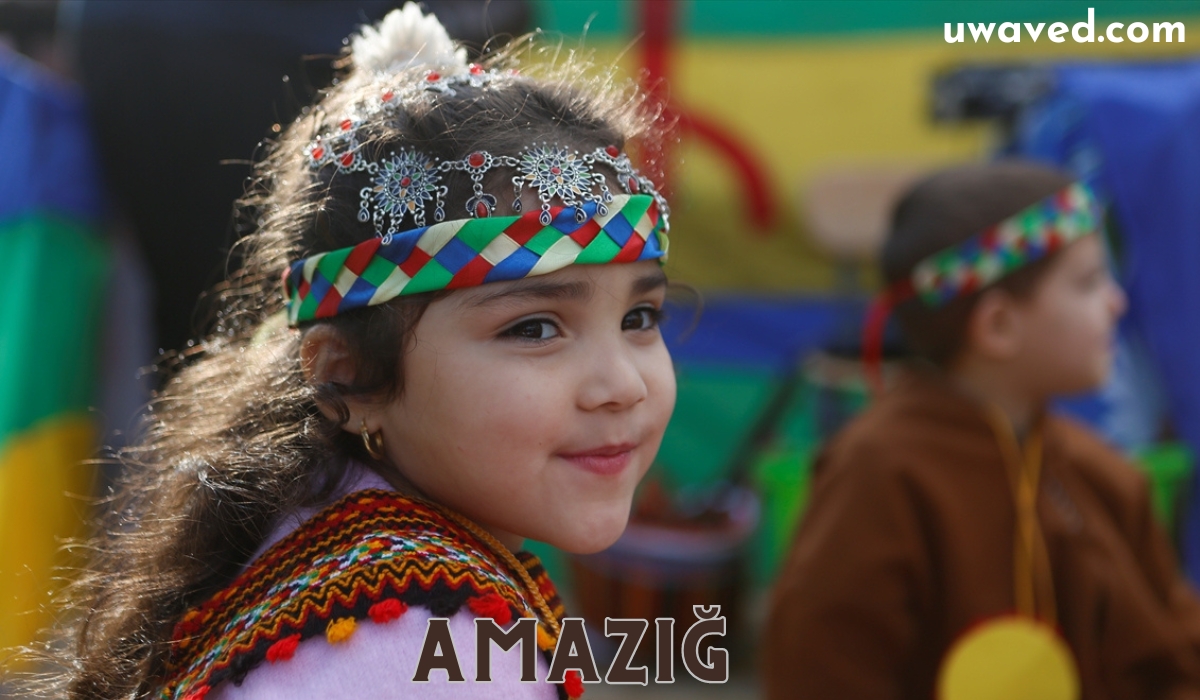Blog
Amaziğ: Unveiling the Rich Tapestry of a Cultural Heritage

Amaziğ
The Amaziğ people, commonly known as Berbers, possess a cultural heritage that is as diverse as it is ancient – a tapestry woven with the threads of history, art, music, and customs that reflect the soul of North Africa. This blog post is a deep-dive into the multifaceted world of Amaziğ culture, a foray into understanding a heritage that has withstood the winds of change for millennia. For anyone intrigued by a rich yet often overlooked corner of our human story, this post stands as an invitation to unravel the beauty and complexity of Amaziğ culture, celebrating the enduring spirit of a people spread across the regions of Morocco, Algeria, Tunisia, Libya, Mauritania, Mali, and the Canary Islands.
An Overview of Amaziğ Culture
To begin our cultural odyssey, it is crucial to understand the core essence of Amaziğ civilization. The Amaziğ community is a vast ethnic group of indigenous North African communities united by a shared linguistic, historical, and cultural background. Their cultural fabric is intricately patterned by nomadic lifestyles, historical struggles, and a deeply rooted connection to the land they call home. Considered the original inhabitants of North Africa, the Amaziğ people have maintained unique customs, a strong communal identity, and a mélange of traditions that continue to captivate the imagination of those keen on exploring the world’s diverse tapestries.
The Significance of Cultural Preservation
Before we venture further, it’s important to highlight why the preservation of cultural heritage, especially that of indigenous communities like the Amaziğ, is critical. Cultural preservation is more than just nostalgia; it’s a bridge that connects the past, present, and future. It offers insight into the origins of our values, norms, and community formations. In an increasingly globalized world, where cultural homogenization is a looming threat, acknowledging and safeguarding diverse cultural legacies is an act of resilience and reverence. By nurturing these unique identities, we contribute to a richer global cultural mosaic – a world where myriad voices and histories can thrive.
Historical Context of the Amaziğ People
To comprehend the multi-layered Amaziğ culture, a historical lens proves invaluable. Here, we will explore the deep roots of the Amaziğ people, tracing their origins, migration patterns, and historical milestones that have shaped their narrative.
Tracking Amaziğ Ancestry and Migrations
The Amaziğ people are believed to be descendants of the pre-Arab inhabitants of North Africa – a mosaic of past civilizations including the Phoenician and Roman influences. Their migration patterns, fueled by various historical events, have intricately tied their fates with neighboring societies. Amaziğ migrations southward into the Sahel and the Niger Bend region, for instance, reflect not only a pursuit of fertile land but also a blending of cultures that continues to manifest in the present day.
Influence on Neighboring Civilizations
The Amaziğ culture, defined by a willingness to adopt and adapt, has made considerable contributions to the cultural development of the Mediterranean region. Notably, the Amaziğ impact on the Roman Empire, including their renowned military might and intellectual prowess, leaves an indelible mark in the annals of Western history.
Key Historical Events Shaping Amaziğ Identity
Several seminal events have etched the Amaziğ identity, such as the Arabization and Islamization of the region. The Amaziğ resistance to these influences, including the formidable Barbary Coast corsairs, exemplifies a long-standing valor and an unwavering spirit of independence.
Language and Literature in the Amaziğ Universe
The linguistic diversity among the Amaziğ constitutes a significant aspect of their heritage. Unveiling the richness of their language and literary traditions is crucial to appreciating the depth and nuanced beauty of their culture.
A Tapestry of Languges: Understanding Amaziğ Dialects
The Amaziğ culture flourishes in a linguistic terrain as varied as the landscape they inhabit. With dozens of distinct Amaziğ languages and dialects, each reflective of specific community traits and historical nuances, the language serves as a repository of cultural knowledge and a testament to the community’s resilience in preserving its unique attributes.
The Role of Language in Cultural Preservation
Language is the marrow that sustains the bones of any culture, and in the case of the Amaziğ, it is the keystone in the archway of their heritage. Efforts to standardize and promote Amaziğ languages have seen significant strides in recent years, ensuring that the linguistic legacy of the community continues to be a communicative vessel of its cultural intricacies.
Literary Luminaries and Their Works
Amaziğ literature has gifted the world with timeless stories, poems, and philosophical musings. From millennia-old oral traditions to noteworthy contemporary authors, the literary heritage of the Amaziğ is a treasure trove waiting to be explored and shared, enriching the global conversation on human expression.
Traditional Arts and Crafts as Cultural Expressions
The craft traditions of the Amaziğ people are not just about the skillful creation of objects; they are a vibrant expression of the community’s identity and values. Here, we will immerse ourselves in the artistic world of the Amaziğ, which continues to fascinate with its authenticity and diversity.
Aesthetic Traditions: A Look into Amaziğ Art
Traditional Amaziğ art encompasses a wide spectrum, from the intricate geometrical designs of Berber carpets to the symbolic motifs etched into talismans. Each art form exudes a sense of spirituality and connectedness to nature—themes recurrent in Amaziğ cultural expressions.
The Role of Art in Cultural Discourse
Art in Amaziğ culture serves as a conduit for stories, beliefs, and communal memory. The distinctive color palettes, patterns, and techniques used in various art forms convey layers of meanings that are not always immediately apparent. Through our exploration, we aim to decode these cultural signifiers and appreciate the profound messages encapsulated in Amaziğ art.
Challenges Faced by Traditional Artisans
In the face of modernization, traditional Amaziğ artisans often grapple with economic and cultural challenges. The preservation of these ancient crafts requires a delicate balance between sustaining livelihoods and maintaining the integrity of artistic traditions. We will discuss these challenges and the innovative methods that artisans are employing to ensure their crafts endure.
Music and Dance: Lively Rhythms of Amaziğ Culture
Amaziğ music and dance form the heartbeat of their cultural expression, reflecting the community’s mood, beliefs, and heritage. In this section, we will celebrate the diversity of Amaziğ musical traditions and explore the vibrant world of their dances.
Musical Traditions: A Symphony of Diversity
From the haunting melodies of the Amaziğ nomads of the Sahara to the energetic rhythms of the Atlas Mountains, Amaziğ music encompasses a wide array of genres and styles. Instruments like the bendir, a frame drum, and the gimbri, a lute-like string instrument, add a distinctive flavor to their musical tapestry.
Dance as a Ritual and Celebration
Traditional Amaziğ dance encompasses both ritualistic and celebratory elements. The Aïta, for instance, is a powerful and emotive form of folk dance and music often performed at community events and rites of passage. Our exploration will take us through the social and cultural significance of these dances, as well as the ancient, primordial connection to the land and life cycles they represent.
Global Influences and Amaziğ Music
The influence of Amaziğ music extends beyond the region, resonating with global audiences and even finding its way into contemporary genres. We will investigate the ways in which Amaziğ music has left an indelible imprint on the world stage, shaping the cultural exchange and mutual understanding among nations.
Religion and Belief Systems in Amaziğ Context
The spiritual realm is an integral part of Amaziğ identity, often bridging the gap between the past and the present. In this section, we will explore the traditional belief systems and their contemporary manifestations within Amaziğ society.
Ancestor Worship and Naturalism
The Amaziğ traditionally venerate their ancestors and maintain a close relationship with the natural world. We will dissect the beliefs and rituals surrounding ancestral spirits and the animistic practices that have sustained the Amaziğ people for centuries.
Confluence of Indigenous Religions and Islam
With the advent of Islam, the Amaziğ people underwent a religious transformation, yet maintained distinct elements of their traditional faith. This section will examine the syncretism between Amaziğ indigenous religions and Islam, showcasing the adaptability and coherence of their spiritual cosmos.
Sacred Spaces and Ceremonies
Amaziğ culture is replete with sacred sites and ceremonies that form the bedrock of their community. We will visit these hallowed grounds and partake in their mystical allure, tracing the significance of these sites within the Amaziğ belief systems and collective memory.
Culinary Traditions: Savoring the Tastes of Amaziğ Culture
Cuisine is a cultural phenomenon, and the culinary traditions of the Amaziğ people offer a delectable insight into their way of life. Join us as we savor the flavors and unravel the stories woven into Amaziğ dishes.
Exploring Traditional Amaziğ Recipes
The rich agricultural heritage of the Amaziğ people has given rise to a diverse and flavorful cuisine. We will dig into some traditional Amaziğ recipes, from savory tagines to the sweet, aromatic world of Amaziğ pastries, each dish a gastronomic delight and a narrative in its own right.
Food as a Social and Cultural Marker
In Amaziğ culture, food plays a central role in social bonding and cultural celebrations. The etiquettes around food consumption and the communal values it reflects paint a picture of a society deeply rooted in hospitality and shared experience. Our discussion will highlight the integral relationship between food and the Amaziğ social fabric.
Adapting to Modern Palates and Preservation Efforts
The centuries-old culinary traditions of the Amaziğ face the challenge of adapting to modern tastes and lifestyles. We will examine the efforts to preserve these traditions, such as culinary workshops and the promotion of traditional ingredients, ensuring that the essence of Amaziğ cuisine continues to thrive.
Cultural Festivals and Celebrations of the Amaziğ People
The calendar of the Amaziğ people is dotted with festivals and celebrations that mark various milestones and natural events. Here, we will take a peek into the kaleidoscope of festivities that animate the cultural life of the community.
Overview of Major Amaziğ Festivals
From the Imilchil Marriage Festival in the Atlas Mountains to the Land Day Festival in southern Tunisia, the Amaziğ people celebrate a myriad of festivals unique to their culture. Each event holds specific customs and stories that bind the community in celebration and reflection.
Symbolism and Significance of Key Cultural Events
Every festival of the Amaziğ people carries within it a deep symbolism and historical significance. We will decode the meaning behind these celebrations, exploring the cultural and spiritual messages they impart, and the role they play in reinforcing collective identity and values.
Tourism and Festivals: Striking a Balance
The increasing interest of tourists in Amaziğ festivals presents both opportunities and challenges. While tourism can bolster cultural recognition and economic growth, it also brings the risk of commodifying traditions. Our section will dissect this double-edged sword and propose strategies for sustainable tourism that respects the cultural integrity of the Amaziğ community.
Challenges and Preservation Efforts of Amaziğ Cultural Heritage
Amaziğ culture, like many ancient traditions, faces an array of contemporary challenges. Here, we will dissect these challenges and survey the horizon for initiatives striving to safeguard the multifaceted heritage of the Amaziğ people.
Globalization and Urbanization: Threats to Amaziğ Heritage
The relentless wave of globalization and urbanization poses a clear and present danger to the survival of indigenous cultures worldwide, and the Amaziğ culture is no exception. We will outline the specific ways in which these phenomena erode cultural heritage and the urgent need to counteract them.
Preservation Initiatives and Organizations
Thankfully, preservation efforts for the Amaziğ cultural heritage are not scarce. A variety of initiatives and organizations are working tirelessly to document, promote, and protect Amaziğ customs and traditions. We will spotlight some of these admirable endeavors, shedding light on the passionate individuals and groups at the forefront of cultural conservation.
Strategies for Sustainable Development and Heritage Safeguarding
Moving forward, a critical conversation revolves around ensuring sustainable development while maintaining cultural identity. We will discuss innovative approaches that blend economic growth with heritage protection, underlining the importance of community involvement and collaboration to achieve a harmonious balance.
YOU MAY ALSO LIKE
Integremos | Tech Solutions: Navigating the Waves of Innovation
Conclusion: The Universal Value of Cultural Diversity
In conclusion, our exploration of the Amaziğ cultural universe offers a compelling case for the universal value of cultural diversity. The preservation and understanding of cultural heritages, such as that of the Amaziğ, serve as a testament to the beauty and resilience of human creativity. It is an invitation to reflect on the broader significance of cultural conservation in fostering a world that appreciates and celebrates the mosaic of human experiences.
Call to Action
Our collective responsibility is to cherish and safeguard the diverse cultural tapestries that make our world an endlessly fascinating place. To this end, we encourage continued learning, support for preservation efforts, and the promotion of respectful cultural exchange. By doing so, we ensure that the legacy of communities like the Amaziğ continues to inspire and enrich our shared human narrative.
In the vast desert sands and rugged mountain landscapes of North Africa lies a cultural gem, the Amaziğ civilization — an intricate tapestry that reflects the depth and complexity of human experience. By peeling back the layers of this rich heritage, we gain not only a window into the soul of the Amaziğ people but also a mirror that reflects the beauty of diversity and the power of the human spirit to endure and innovate. It is a narrative that beckons us to immerse ourselves, learn, and engage, for within the cultural treasure trove of the Amaziğ, we find a universal message that resonates with all humanity.
Frequently Asked Questions (FAQs)
What is the Amaziğ Culture?
The Amaziğ culture represents the indigenous peoples of North Africa, known for their rich traditions, languages, and historical significance that predates Arab influences in the region. Esteemed for their expertise in agriculture, craftsmanship, and robust societal structures, the Amaziğ people have contributed significantly to the cultural mosaic of North Africa.
What are the major festivals celebrated by the Amaziğ People?
Major festivals include the Imilchil Marriage Festival, which celebrates communal bonds and matrimonial alliances, and the Land Day Festival in southern Tunisia, marking the beginning of the agricultural season. These festivities showcase the vibrant traditions and deep-rooted cultural values of the Amaziğ community.
How is the Amaziğ Culture being preserved?
Amaziğ culture is being preserved through a variety of initiatives and organizations dedicated to documenting, promoting, and protecting their customs and traditions. Efforts include culinary workshops to preserve traditional cooking methods, the promotion of traditional Amaziğ languages in education, and festivals that showcase Amaziğ history and arts to a global audience.
What challenges does the Amaziğ Culture face?
The Amaziğ culture faces challenges from globalization and urbanization, which threaten traditional ways of life and cultural expressions. Additionally, there’s an ongoing struggle for cultural recognition and rights within modern nation-states, which occasionally sidelines indigenous identities and languages.
How can people support the preservation of Amaziğ Culture?
Supporting the preservation of Amaziğ culture can be achieved through promoting respectful cultural exchanges, engaging with and supporting organizations that work towards the conservation and promotion of Amaziğ traditions, and by being mindful tourists when attending cultural festivals to ensure that the presence of visitors does not commodify or harm the integrity of these traditions.

-

 Pets and Animals4 months ago
Pets and Animals4 months agoShovel Dog: Everything You Need to Know
-

 Pets and Animals4 months ago
Pets and Animals4 months agoHow To Trim Dog Nails: A Step-by-Step Guide for Painless Pups and Peace of Mind
-

 Pets and Animals4 months ago
Pets and Animals4 months agoBubonic Plague case oregon cat: A Modern Tale of Medieval Disease
-

 Pets and Animals4 months ago
Pets and Animals4 months agoBlack Beauty: Unveiling the Alluring Pitbull Dog Black
-

 Pet Care Guides4 months ago
Pet Care Guides4 months agoHere’s Why Nationwide Pet Insurance Should Be on Your Radar
-

 Pets and Animals4 months ago
Pets and Animals4 months agoHow Often Do You Take A Cat to the Vet? A Guide for Caring Owners
-

 Other4 months ago
Other4 months agoHow to Hello kitty drawing: A Step-by-Step Guide for Fans of All Ages
-

 Pet Care Guides4 months ago
Pet Care Guides4 months agoGive a Loving Home: Adopt a Pet, Change a Life with Pet finder